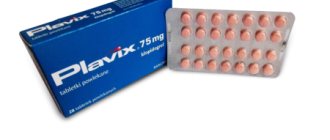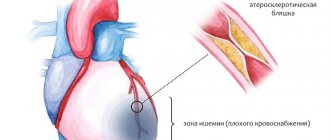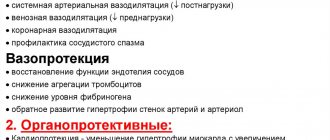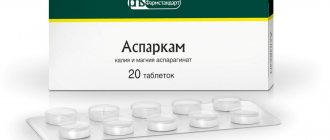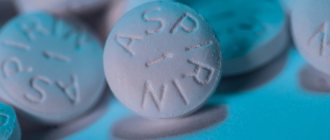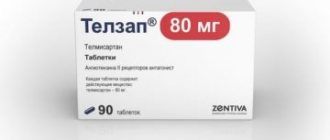Hypertensive patients often find that many medications only lower blood pressure. They are prescribed other medications to treat heart disease.
Hartil is a drug that acts not only on blood pressure. It helps relieve stress from the entire cardiovascular system.
If the muscle of the organ is hypertrophied, the medication restores its previous volume. Regular use of Hartil reduces the number of arrhythmias, improves breathing and heart nutrition.
Composition and release form
The drug Hartil is available in the form of film-coated tablets. They are oval in shape, chamfered, scored and engraved on one side. Marbling is allowed in the color of the shell.
Hartil tablets are available in the following dosages:
- 2.5 mg. They have a lemon or rich yellow color. R2 is engraved on the side surface.
- Hartil 5 mg. They have a pinkish or pinkish-orange color. R3 is engraved on the side surface.
- 10 mg. White/almost white. R4 is engraved on the side surface.
Hartil, the composition of which includes active and additional substances, contains:
| Name of substance | Action |
| Active substance | |
| Ramipril | Effectively lowers blood pressure, effectively dilates blood vessels, leads to regression of myocardial hypertrophy, and has a cardioprotective effect. |
| Additional substances | |
| Sodium bicarbonate (baking soda) | Used as a disinfectant. It neutralizes acid in the stomach. |
| Lactose monohydrate (milk sugar) | Used as a filler. Strictly prohibited in case of individual lactose intolerance. |
| Gelatinized starch | It is corn starch after chemical treatment. The substance is highly hygroscopic and is used as a thickener. |
| Croscarmellose sodium | Promotes rapid dissolution of the tablet in the stomach. Accelerates the release of active substances. |
| Sodium stearyl fumarate | Thickener, analogue of magnesium stearate. |
How do Hartil tablets work?
After administration, the drug reduces blood pressure within 60–120 minutes and maintains it throughout the day. The active ingredient in the composition is ramipril. It is due to its content that the medicine Hartil has a therapeutic effect. The mechanism of action includes:
- Reduced production of the hormone angiotensin, which contributes to the narrowing of the lumen of blood vessels.
- It has a suppressive (inhibiting) effect on the functioning of the hormonal system responsible for increasing blood pressure.
- Reduces the amount of norepinephrine released into the blood. This hormone increases the number of heart contractions, constricts blood vessels and increases blood pressure.
- Suppresses the synthesis of a hormone that leads to an increase in blood pressure due to the increased amount of circulating blood - aldosterone.
- Helps increase the concentration of bradykinin by suppressing its breakdown. Bradykinin helps lower blood pressure.
- Expands the lumen of the renal vessels.
- It has a cardioprotective effect on the chambers and tissues of the heart muscle.
- Accelerates the production of nitric oxide, which can restore myocardial cells.
- Reduces total peripheral vascular resistance, improves blood circulation, and helps reduce blood clots.
Distribution of angiotensin-converting enzyme in the body and its effects
Interaction with other drugs
When taken together with the drug, diuretics, as well as drugs that have an inhibitory effect on the central nervous system, the antihypertensive property of the drug increases.
The combination of non-steroidal anti-inflammatory drugs and Hartil, as well as drugs containing estrogen, reduces this effect. If such interaction is necessary, the doctor must exercise strict control over the patient's condition.
Taking medications that increase the level of potassium in the blood, cyclosporine and milk together with Hartil can cause hyperkalemia. Hartil increases the amount of lithium when used together with lithium-containing drugs, reduces sugar levels when combined with hypoglycemic agents.
Alopurinol and immunosuppressants in combination with Hartil increase the likelihood of leukopenia. Alcoholic drinks increase its inhibitory effect on the central nervous system.
Indications for use
The drug Hartil, which is prescribed only after visiting a doctor, is used for a number of conditions. Among them:
- Hypertension (persistent increase in blood pressure).
- Chronic heart failure. It is a permanent disruption of the heart muscle, leading to insufficient blood flow to organs and tissues. Develops over a long period of time.
- Chronic heart failure resulting from myocardial infarction. Use is only possible in patients with stable blood flow through the vessels.
- Diabetic nephropathy. Occurs in ¾ of patients with diabetes. It is a lesion of the glomeruli, tubules and vessels of the kidneys.
- Nondiabetic nephropathy. Disorders of the kidneys caused by damage to their elements by various factors.
- To reduce the likelihood of myocardial infarction or sudden death in patients suffering from ischemia. Hartil can be used for patients who have undergone surgical treatment of coronary disease.
You can learn about the consequences of hypertension on our website KrasotaDiet.ru and on the MedNews.info website.
Pharmacological group
The drug Hartil is an adenosine-converting enzyme (ACE) inhibitor. Due to the suppression of ACE, the level of angiotensin II decreases, which leads to a decrease in the production of aldosterone. Under the influence of ramipril, afterload, preload in the pulmonary capillaries, and total peripheral vascular resistance decrease, the tolerance of the cardiovascular system to physical activity increases, and cardiac output increases.
Ramipril helps prevent and reverse the development of cardiac muscle hypertrophy in patients with arterial hypertension. The drug also reduces heart rate and improves blood circulation in the myocardium subject to ischemia.
Rapidly absorbed into the gastrointestinal tract. The maximum concentration of ramipril in the blood is achieved 1 hour after taking Hartil. Metabolized in the liver to form active ramiprilat. The half-life of ramipril is 5 hours, while that of ramiprilat is 13 to 17 hours. Excreted in urine and feces.
Instructions for use
Important information about the peculiarities of administration and contraindications can be emphasized in the annotation for the drug. Before taking the product, be sure to read the attached recommendations.
In particular, Hartil, the instructions for use of which contain a complete list of restrictions, should be used with caution when:
- Mitral valve stenosis. The condition is expressed in the closure of the lumen between the left ventricle and the atrium. This leads to obstruction of blood flow. Taking the drug can lead to an excessive drop in blood pressure and negatively affect kidney function.
- Aortic stenosis affecting hemodynamics. Usually caused by hypertrophied myocardium, which becomes an obstacle to blood flow. Hartil in this case can cause a decrease in blood pressure and negatively affect the kidneys.
- Complex forms of primary type arterial hypertension. Hartil should be taken with extreme caution at blood pressure above 180/120 mmHg.
- Reducing the concentration of sodium ions to 135 mmol/l or less (hyponatremia).
- Diseases of a systemic nature that affect connective tissue.
- Kidney/liver failure and so on.
Overdose
Symptoms: marked decrease in blood pressure, bradycardia, shock, water and electrolyte imbalance, acute renal failure.
Treatment: in case of mild overdose - gastric lavage, administration of adsorbents and sodium sulfate (preferably within 30 minutes after administration).
In case of acute overdose: monitoring and maintaining vital functions in the intensive care unit; when blood pressure decreases, administer catecholamines and angiotensin II. The patient should be placed on his back with his legs elevated; the introduction of additional amounts of fluid and sodium is indicated.
It is not known whether forced diuresis, hemofiltration and correction of urine pH accelerate the elimination of ramipril. This should be taken into account when considering the possibility of hemodialysis and hemofiltration (see “Contraindications”).
Dosage
Hartil, whose indications for use are quite broad, is used in various dosages, based on the purpose of therapy.
| Diagnosis | Recommended dosage | special instructions |
| Hypertension | 2.5-10 mg | You should start taking Hartil for blood pressure with a minimum dosage. It can be gradually increased, but not more often than once every 10-21 days. Should be taken once a day. The dose in which Hartil can be taken is 10 mg (the instructions for use prohibit increasing the dosage). |
| Chronic heart failure | 1.25-10 mg | Initially - 1.25. After 14 or more days, the dose can be doubled. It is forbidden to take more than 10 mg per day. Hartil can be drunk once/twice a day. |
| Therapy after myocardial infarction | 2.5-10 mg | Treatment is prescribed 3-10 days after the attack. The initial dose per day is 2.5 mg (sometimes 5). Maximum – 10 mg per day. If side effects occur, the dosage should be reduced. Should be taken 2 times a day. |
| Preventive measures (at risk of myocardial infarction, stroke, death) | 2.5-10 mg | The initial dose is 2.5 mg. It should be increased every 14-21 days, but not more than 10 mg. |
| Diabetic/non-diabetic nephropathy | 1.25-5 mg | Therapy involves complete exclusion of diuretics. The dosage can be increased every 20-28 days, but not more than 5 mg per day. |
| For persons over 65 years of age | 1.25-10 mg | The dosage is selected based on the specific case. |
| For renal failure | 1,25-5 | Hartil should be taken with extreme caution, monitoring creatinine clearance. |
| For liver failure | 1,25-2,5 | Only under supervision. |
| When combined with diuretics | Reduce the dose or discontinue Hartil (preferably a few days before starting Hartil). |
Applications and dosages
Hartil tablets should be taken orally, without chewing, with a sufficient amount of clean water. The dosage is selected individually for each patient based on the nature of the pathology, degree of tolerability and current state of health of the person. The use of tablets does not depend on the time of meals.
for adults
Adult patients are recommended to start therapy with Hartil with 2.5 mg once a day. Increasing the dosage should be agreed with the attending physician. The maximum daily dosage is 10 mg.
for children
In children under 18 years of age, taking the drug Hartil is contraindicated.
for pregnant women and during lactation
Due to the lack of data on the safety and effectiveness of Hartil in pregnant and lactating women, use in these groups of patients is unacceptable.
Side effects
Taking the drug may cause a negative reaction in the body. Hartil, whose side effects can manifest themselves in different ways, has its own list of possible consequences.
| Localization | Manifestations |
| The cardiovascular system | Excessive decrease in blood pressure, reduction in systolic pressure, risk of myocardial infarction/angina pectoris attack, risk of stroke, etc. |
| Genitourinary | Impaired kidney function, decreased urine output, decreased sexual desire, etc. |
| CNS | Fatigue, loss of concentration, drowsiness, headaches, sleep disturbances, fatigue, spasms, etc. |
| Sense organs | Incorrect perception of taste/sounds, extraneous noise, etc. |
| Gastrointestinal organs | Diarrhea, vomiting, heartburn, likelihood of drug-induced hepatitis, stomatitis, etc. |
| Organs of the respiratory system | Rhinorrhea, coughing attacks, spasms in the throat or bronchi, onychiliosis, angioedema, etc. |
| Hematopoietic system | Increased sweating, fever, bone marrow depression, anemia, etc. |
| Skin/mucous membranes | Angioedema, anaphylactic shock, urticaria, eczema, dermatitis, etc. |
If any side effects occur, you should stop taking the drug.
Contraindications for use
There are a number of conditions in which it is prohibited to take Hartil; the contraindications are as follows:
- The occurrence of allergic reactions to active or auxiliary substances.
- Lactose intolerance.
- Detection of Quincke's edema at the moment or angioedema that occurred earlier after taking the drug or its analogues.
- Stenosis of the vessels of one or both kidneys, affecting hemodynamics.
- Age up to 18 years (due to the lack of studies confirming the safety of Hartil for this age group).
- Planning pregnancy, bearing a child, breastfeeding. Some women, unaware of their pregnancy, continue to take Hartil tablets, which may cause developmental disorders, kidney failure, or excessively low blood pressure in the child.
- Excessive synthesis of the hormone aldosterone.
- Impaired kidney function.
Ramigamma
The next analogue of the drug “Hartil” is also quite widespread among patients in Russia. This drug is called Ramigamma. As in most of the other analogue examples we have considered, the main active ingredient in Ramigamma is ramipril. All indications for use and contraindications are identical to all the products that we reviewed earlier. The course of treatment with the use of this drug should take place after consultation with the attending physician and under his close supervision.
After the first use of Ramigamma or after increasing the dose of a diuretic medication, it is recommended to measure blood pressure as often as possible in the next 8-10 hours. This recommendation is given due to the fact that an uncontrolled decrease in blood pressure may develop. Blood pressure monitoring will help avoid this effect
Patients who have been diagnosed with severe pathologies of the kidneys or cardiovascular system should take the drug with caution.
To avoid the development of leukopenia, a test should be performed periodically to show the level of leukocytes in the blood.
Parallel use of Hartil or any of its analogues and a sensitizing agent can cause the development of complex anaphylactic reactions, which can become a threat to the patient’s life. Manifestations of such an anaphylactic reaction include vomiting, a sharp drop in blood pressure, and difficulty breathing. In this regard, doctors strictly prohibit such parallel therapy.
The analogues for the drug “Hartil N” are “Tritace Plus”, “Ramipril-Pfizer”, “Ampril-HL”.
Reviews from patients who took the drug for blood pressure
On the Internet you can find a significant number of opinions about the drug. Hartil, reviews of which are mostly positive, is recommended for:
- High efficiency. The drug actually reduces blood pressure by 20 mm Hg. Art. and more.
- Fast action. Hartil brings relief to the patient in a short time.
- Long lasting effect. Hartil normalizes blood pressure for 24 hours.
However, there are also negative impressions from taking Hartil. Among them:
- an impressive list of possible negative reactions of the body;
- getting used to Hartil;
- high price of medicine.
special instructions
At the very beginning of therapy with Hartil, significant disturbances in concentration and reaction speed may be observed. Also, throughout the course of treatment, side effects such as dizziness, blurred vision and hearing, fainting and confusion may occur. For this reason, while taking Hartil, you should refrain from driving vehicles and carrying out activities that require increased attention and adequate perception of the world around you.
What's better?
A wide range of drugs that have antihypertensive effects makes us think about the advantages of some over others.
Hartil or Prestarium
First of all, it is worth considering the similarities and differences between these medications. Among them:
- The drugs are considered synonyms. They are different in their composition, but produce a similar therapeutic effect. Both belong to the group of angiotensin-converting enzyme (ACE) inhibitors
- Compound. The active substance of Hartil is ramipril, and Prestarium is perindopril.
- Price. Prestarium has a slightly higher cost than Hartil. When considering Hartil or Prestarium, it is impossible to say which is better or worse.
The drug is prescribed based on the individual characteristics of the patient. If allergic reactions, other side effects or lack of effect occur, a specialist may well replace one drug with another. In this case, it will be possible to avoid or reduce the consequences of taking the drug due to different active substances in the composition.
Hartil or Enalapril
These drugs are also synonymous. They have the same therapeutic effect. However:
- The active substance in Enalapril is enalapril (in Hartil it is ramipril).
- Efficiency. It is believed that Hartil lowers blood pressure more effectively. However, this depends on the specific case.
- Price. Enalapril is on average 4 times cheaper than the synonymous drug.
According to various studies conducted in 1992–1997, Hartil shows better results in normalizing blood pressure than many other drugs, including Enalapril. However, its high price and possible side effects do not always allow its use for therapy. When choosing Hartil or Enalapril, only a specialist will answer which is better for a given patient.

